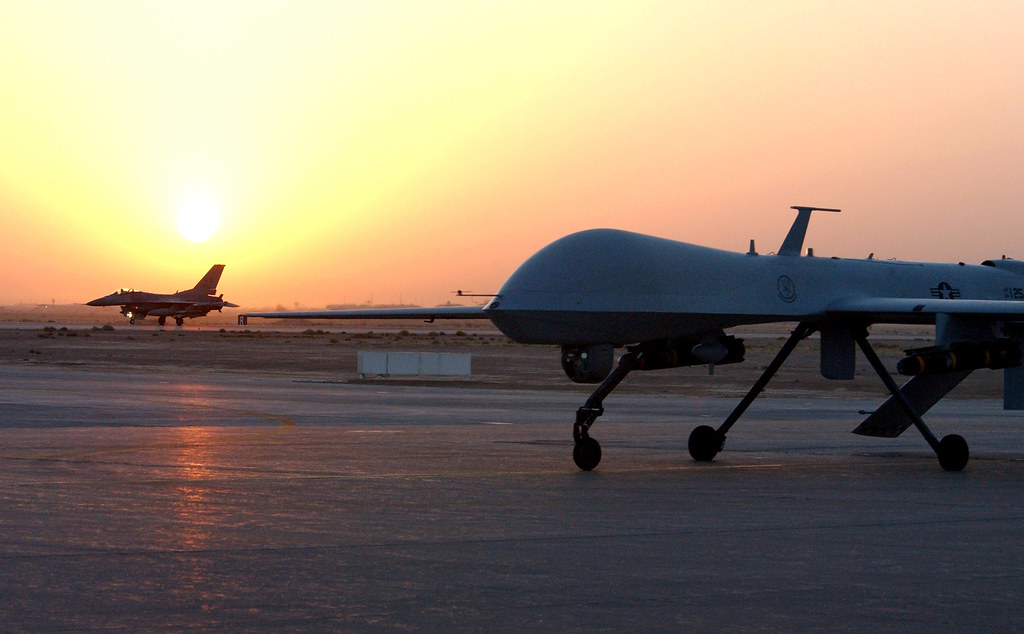
Описание: An MQ-1 Predator unmanned aerial vehicle and F-16 Fighting Falcon return from an Operation Iraqi Freedom combat mission. Both aircraft provide intelligence, search and reconnaissance gathering features, as well as munitions capability to support ground troops and base defense. Mission The MQ-1B Predator is an armed, multi-mission, medium-altitude, long-endurance remotely piloted aircraft that is employed primarily as an intelligence-collection asset and secondarily against dynamic execution targets. Given its significant loiter time, wide-range sensors, multi-mode communications suite, and precision weapons, it provides a unique capability to perform strike, coordination and reconnaissance (SCAR) against high-value, fleeting, and time-sensitive targets. Predators can also perform the following missions and tasks: intelligence, surveillance, reconnaissance, close air support, combat search and rescue, precision strike, buddy-lase, convoy/raid overwatch, route clearance, target development, and terminal air guidance. The MQ-1's capabilities make it uniquely qualified to conduct irregular warfare operations in support of combatant commander objectives. Features The Predator is part of a remotely piloted aircraft system. A fully operational system consists of four sensor/weapon-equipped aircraft, ground control station, Predator Primary Satellite Link, and spare equipment, along with operations and maintenance crews for deployed 24-hour missions. The basic crew for the Predator is a rated pilot to control the aircraft and command the mission, and an enlisted aircrew member to operate sensors and weapons as well as a mission coordinator, when required. The crew employs the aircraft from inside the ground control station via a line-of-sight data link or a satellite data link for beyond line-of-sight operations. The Predator carries the Multi-Spectral Targeting System, which integrates an infrared sensor, color/monochrome daylight TV camera, image-intensified TV camera, laser designator and laser illuminator. The full-motion video from each of the imaging sensors can be viewed as separate video streams or fused. The aircraft can employ two laser-guided missiles, Air-to-Ground Missile-114 Hellfire, that possess highly accurate, low-collateral damage, and anti-armor, anti-personnel engagement capabilities. The remotely piloted aircraft system can be deployed for worldwide operations; likewise, the Predator can be disassembled and loaded into a container for travel. The ground control system and PPSL are transportable in a C-130 Hercules (or larger) transport aircraft. The Predator can operate on a 5,000 by 75-foot (1,524 meters by 23 meters) hard-surface runway with clear line-of-sight to the ground data terminal antenna. The antenna provides line-of-sight communications for takeoff and landing. The PPSL provides over-the-horizon communications for the aircraft and sensors. The primary concept of operations, remote split operations, employs a launch-and-recovery ground control element for take-off and landing operations at the forward operating location, while the crew based in the continental United States executes command and control of the remainder of the mission via beyond-line-of-sight links. Remote split operations result in a smaller number of personnel deployed to a forward location, consolidate control of the different flights in one location, and as such, simplify command and control functions as well as the logistical supply challenges for the weapons system. The aircraft has an ARC-210 radio, APX-100 IFF/SIF with Mode 4, and upgraded turbocharged engine. The latest upgrades, which enhance maintenance and performance, include notched tails, split engine cowlings, braided steel hoses, and improved engine blocks. Background The Predator system was designed in response to a Department of Defense requirement to provide to the warfighter persistent intelligence, surveillance, and reconnaissance information combined with a strike capability. In April 1996, the secretary of defense selected the U.S. Air Force as the operating service for the RQ-1 Predator system. The "R" is the Department of Defense designation for reconnaissance aircraft. The "M" is the DOD designation for multi-role, and "Q" means remotely piloted aircraft system. The "1" refers to the aircraft being the first of the series of remotely piloted aircraft systems. A change in designation from "RQ-1" to "MQ-1" occurred in 2002 with the addition of the AGM-114 Hellfire missiles, enabling reaction against intelligence, surveillance, and reconnaissance, close air support, and interdiction targets. The Predator remotely piloted aircraft system continues to provide required armed intelligence, surveillance, and reconnaissance capabilities to overseas contingency operations warfighters. During August 2011, the Predator surpassed one million hours of total development, test, training, and combat - a significant accomplishment for the U.S. Air Force.
Tags:
Поиск и фотоизображения предоставлены компанией Flickr с помощью сервиса Flickr API согласно Правилам пользования сайтом Flick.com и его сервисами. Графические изображения являются публичными, размещёнными их авторами в свободный доступ (Public) и физически расположены на серверах Flickr. Все права на фотографии принадлежат их авторам согласно пользовательскому соглашению сервиса Flickr.com и охраняются законами, регулирующими авторские права.